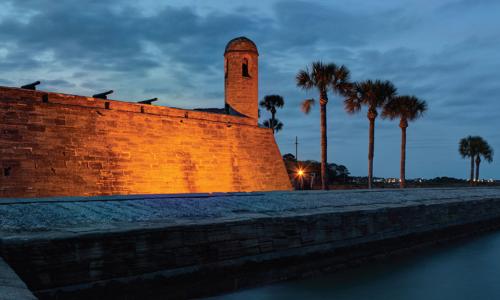This profile is excerpted from the 2014 report, "National Landmarks at Risk: How Rising Seas, Floods, and Wildfires Are Threatening the United States' Most Cherished Historic Sites"
Some of the most remarkable archaeological remains in the world are under severe threat from rising sea levels. The huge prehistoric mounds of oyster and clam shells that dot Florida’s Gulf and Atlantic coasts may hold the key to understanding the mysteries of Florida’s past—but only if we can protect them from worsening erosion and storm damage.
For 4,000 years, early indigenous Floridians lived among the Ten Thousand Islands, an area of keys and mangroves on the southwestern Gulf Coast, now partly within Everglades National Park. They lived off the rich biological resources in and near these shallow coastal waters, eating a wide variety of foods including meat from turtles, small mammals, and deer, but getting most of their nutrition from fish and shellfish. Over time, they dumped millions of oyster shells in waste piles called middens, which may also have served as a reservoir of potentially useful materials; these indigenous peoples made tools and other objects including hammers, cutting implements, and vessels from conch and whelk shells.
Prehistoric shell middens are common along the U.S. coastline, but Florida’s are unique. The state is one of the only places on Earth where coastal hunter-gatherers built such large and complicated shell structures. The shell works, or shell mound complexes of the Ten Thousand Islands region, boast features such as “finger ridges,” “plazas,” canals, and “water courts.” Just a few meters high and often in direct contact with the water at their bases, they were built over many centuries to serve the needs of a growing and well-organized society.
At Dismal Key, for example, low canals run between the finger ridges radiating out to the edge of the site. These canals may have acted as fish traps, water control structures, or channels for canoes to access the community; water courts could have been used to store or even grow fish or shellfish in some form of aquaculture. The oldest parts of many of these architectural shell complexes are often large ring-shaped shell structures.
Artifacts found on some of these rings, such as drilled sharks’ teeth, worked stingray spines, and a limestone pendant suggest they were used for ceremonial purposes or for high-status residences. Clearly these were vibrant and structured communities, and at the time of the first European contact in 1513 there may have been tens of thousands of indigenous Calusa, Timucuan, and other tribes in Florida. But by the mid-1700s they had all but disappeared, victims of disease, warfare, and the slave trade.
Across the Florida peninsula, on the Atlantic coast, lies another massive shell mound. At more than 35 feet tall and covering two acres, Turtle Mound in the northern part of Canaveral National Seashore is thought to be the highest in North America. The mound dates back at least 1,200 years and is such a remarkable feature of this low-lying coast that it was shown as a navigational aid on the first Spanish maps of the region.
Erosion has recently become a major problem for Turtle Mound. Sea level rise, combined with storm surges and boat wakes, has had particularly severe impacts on the mound. Fears that this archaeological treasure could be irreparably damaged have recently prompted the National Park Service to join with scientists at the University of Central Florida in a project to protect Turtle Mound from erosion. Toward that end, they are creating “living shorelines” consisting of submerged mats of oysters, newly planted spartina grass, and mangroves.
Florida has recorded a sea level rise of eight to nine inches in the last 100 years, and state authorities are projecting an accelerated rise of another 9 to 24 inches by 2060.
In the Everglades, this phenomenon is already causing problems. Erosion and storm damage, exacerbated by sea level rise, have collapsed the banks of tidal creeks at Sandfly Key, threatening the important shell-work structures there.
The accelerating rate of sea level rise, combined with extreme rainfall events (which are predicted to increase) and their accompanying storm surges, will pose a growing threat to Florida’s extraordinary prehistoric shell mound complexes in the coming decades. Archaeologists are now in a race against time to unlock the secrets of some of the country’s earliest inhabitants.




